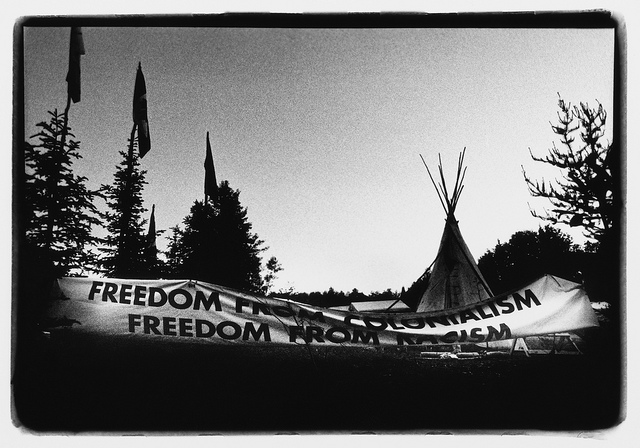Like this article? rabble is reader-supported journalism. Chip in to keep stories like these coming.
UPDATE: Yesterday six Grassy Narrows supporters were arrested and held overnight. They had a bail hearing on Friday morning in Toronto and were charged.
The supporters are calling for action on the mercury contamination near Grassy Narrows. Watch and share this video to show your support.
BREAKING: According to No One Is Illegal, five people have been arrested and Kathleen Wynne has not responded to calls to clean up the river.
BREAKING: Supporters of Grassy Narrows have set up a chemical dump at Queen’s Park in Toronto to demand that Kathleen Wynne and the Ontario government take action and clean up the mercury contamination in the water.
Call Wynne and demand action for Grassy Narrows here.
Sign the petition to demand the mercury be cleaned up.
Former Dryden Paper Mill worker Kas Glowacki revealed in a troubling confession letter sent to the former Grassy Narrows Chief Paul Watts the location of a mercury disposal site near the Grassy Narrows First Nation.
Glowacki divulged in the email last August that while working as Mill labourer from around 1971 until 1974, he participated in the disposal of at least 50 barrels of salt and mercury mixture in a large, shallow pit behind the mill.
Yesterday, a Toronto Star investigation revealed that the Ontario government ignored Glowacki’s email for eight months.
This information comes after a recent study, commissioned by the Ontario provincial government and the Grassy Narrows First Nation, determined that the decades of mercury poisioning of the Wabigoon-English River system could be cleaned up.
No formal commitment to clean up the river has been made by the government while the Grassy Narrows First Nation and its allies continue to call for action from Kathleen Wynne and her government.
Continued government inaction, confusion “disturbing” to community
“I am writing this letter out of guilt,” Glowacki wrote in his letter to Chief Watts.
“I can attest to the fact that there was several hundred pounds [of mercury] buried up on the hill above the river.
“I was amazed at the amount of mercury that was pooling around my shovel as I dumped it into the drums,” Glowacki said describing how the drums were “dropped, not placed, into pits and then covered with poly[urethane] and buried.”
Chief Watts forwarded Glowacki’s confession letter to Ontario government officials last August. In November, Ray Boivin, a Senior Environment Officer with the Ontario Ministry of Environment and Climate Change, responded that a mercury disposal site was established in 1971 on a hillside west of the mill, and that the disposal site is “not a site of mercury contamination.”
Boivin also told Watts that the groundwater around the site is subjected to bi-annual mercury analysis testing.
However, Glowacki insisted to Toronto Star reporters that the site he described in his email is not the mercury disposal site Boivin referenced.
The Toronto Star investigation exposed that the ministry did not immediately follow up with Glowacki to ask questions about the location of the site he described.
“It’s very disturbing to us to hear that there might be a site where the mercury has been buried and they don’t know where it is,” Grassy Narrows Chief Simon Fobister Sr. told rabble in a phone interview.
The Grassy Narrows community is disappointed with “the never-ending story that the mercury is still there and still contaminating our food supply […] we’re demanding that Ontario just go ahead and clean up the river, do whatever it takes to get rid of the mercury,” said Chief Fobister.
In 2005, Japanese scientist Dr. Masazumi Harada published a scientific study that found 79 per cent of 187 people in Grassy Narrows, as well as the nearby Wabaseemoong Independent Nations had or still have Minamata disease caused by methyl-mercury poisoning.
Three weeks ago, a scientific report commissioned by the Grassy Narrows First Nation and the provincial government found that over 50 years later, mercury levels in sediments and fish are still 150 times the safe dose recommended by the U.S. Environmental Protection Agency.
Why won’t the government clean up the river?
“We, the people of Grassy Narrows, have lived with mercury poisoning mostly all of our lives,” wrote Judy Da Silva, an environmental activist and member of the Grassy Narrows community, in a text message to rabble.
“We did a sediment study in 2010 that found mercury was still on the top sediment [in] parts of the English-Wabigoon River system when it should have ben already burried by natural sedimentation in the river,” Da Silva continued. “This did not happen. Why? With Glowacki’s testimony it appears these barrels might be part of the cause.”
The investigation has prompted the ministry’s delayed action on the issue. Seven months after receiving Glowacki’s confession, the ministry took samples from two collection ponds in the area, and three days after the Star showed the ministry the approximate location of the disposal site Glowacki describes, inspectors visited the area.
The community is demanding the Ontario government “find these barrels and put them away in a safer place away from human exposure,” said Da Silva.
Gary Wheeler, a communications officer for the Ontario Ministry of Environment and Climate Change, confirmed with rabble in an email that “Ministers [Glen R.] Murray and [David] Zimmer, together with Ministry scientists, will be traveling to meet and work with the Grassy Narrows First Nations at the end of this month.”
Sophia Reuss is a Montreal-based writer, editor, and is a recent graduate of McGill University. She’s interested in how online media and journalism facilitate public accessibility and conversation. Sophia also writes and edits for the Alternatives International Journal. She is rabble’s news intern.
Photo: flickr/Howl Arts Collective



